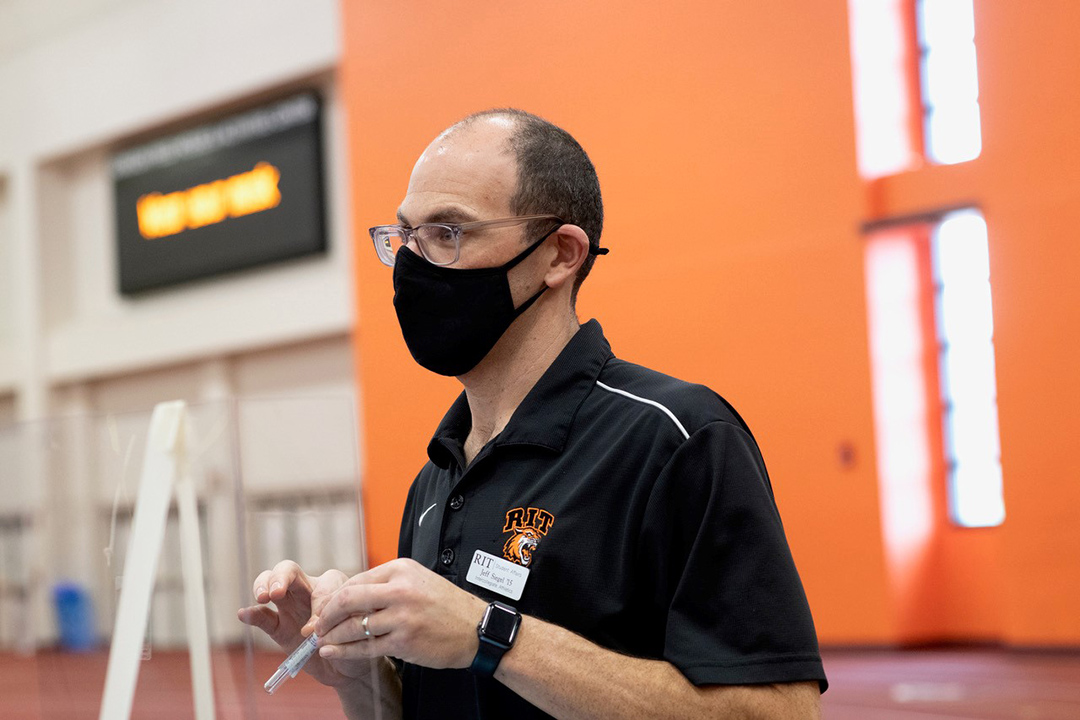Tiger Testing takes a village
A. Sue Weisler
Tiger Testing is a sign of the times and a key strategy in RIT’s COVID-19 response.
The success of RIT’s Tiger Testing campaign is made possible by campus-wide collaborations involving more than 100 employees working behind the scenes to support RIT’s COVID-19 response.
Information and Technology Services Project Management Office and RIT Athletics are two of many departments that have helped the university create a safe environment during the coronavirus pandemic by facilitating high-volume testing this spring. Their efforts have enabled RIT leadership to monitor and mitigate COVID-19 on campus.
Nearly 13,000 students were tested by the end of the fall semester. In contrast, this spring, RIT has tested weekly the entire on-campus student body, or approximately 10,000 students, with a 95 percent compliance rate. This past weekend, RIT topped 100,000 tests administered on campus since January, according to Dr. Wendy Gelbard, RIT associate vice president of Wellness.
“The current situation is positive because the entire campus has worked hard to create a safe and healthy environment,” Gelbard said. “We’re in a good situation because of our campaign, the 3Ws (wash your hands, wear your mask, watch your distance) and now the fourth W (will power) has worked. We are also doing well because our students and employees really want to be here.”
Gelbard leads a small core group of senior leadership who brief RIT President David Munson and his team that includes Melinda Ward, RIT executive director of risk management and insurance; Dr. Lindsay Philips, medical director of RIT’s Student Health Center; and Jennifer Schneider, Eugene H. Fram Chair of Applied Critical Thinking in Academic Affairs. They meet daily to assess factors influencing alert levels on campus, Tiger Testing surveillance, capacity of isolation and quarantine areas, and wastewater data.
“We look at what the indicators are telling us,” Ward said. “Then we present to President Munson and his briefing group who make decisions on a daily basis about alert levels and appropriate safety precautions.”
In a year of back-to-back meetings, Gelbard’s team conferred often with the ITS project management group and the Tiger Testing team. They looked to ITS for technical solutions for health monitoring, contact tracing applications, and consultation with the information technology vendor hired to track and manage results. The high-level support from the project management team helps keep things moving and prioritized, Ward said.
“ITS was faced with a lot of requests for technology to do things—QR codes for contact tracing, daily health screen, the dashboard—so many pieces that require IT. And they had to develop some of these things in-house,” Ward said.
ITS partnered with Rochester General Hospital (RIT and Rochester Regional Health System are strategic partners) to customize the daily health screen. “Our team helped their developers figure out what our questions needed to be by working with Dr. Phillips and Dr. Gelbard at the Student Health Center,” said Kim Sowers, director of RIT’s Project Management Office in ITS. “ITS developed a dashboard for supervisors and supported RIT student mandatory compliance for COVID testing to make sure people were doing the health screen because that’s been a key component of keeping the campus safe.”
In the fall, ITS also supported wastewater responsive testing. When wastewater samples indicated the presence of the coronavirus, ITS was instrumental in coordinating on short notice support for COVID-19 testing for students living in the indicated residential housing, said Lisa Koch, associate CIO of customer engagement and experience in ITS.
A. Sue Weisler
Jeff Siegel oversees Tiger Testing for RIT Athletics.
Gelbard and Ward meet weekly with Jeff Siegel and Emily Heyman to plan for future testing needs, such as for commencement. They are beginning to discuss testing options for the summer and fall.
Siegel ’15 MS (project management), associate athletics director, manages Tiger Testing. He has seen testing evolve throughout the pandemic, from a site held in a parking lot, to the small space called the Fitness Lab in the Student Life Center, to the Gordon Field House. “Now, we are taking up three quarters of the Gordon Field House arena floor,” he said.
Siegel, who typically runs home sports competitions and maintains outdoor facility scheduling, approaches Tiger Testing as if he were managing one massive event.
His team includes Heyman, assistant director of University Arenas in Finance and Administration, and student employee Kerri Zalba, fifth-year software engineering major from Mentor, Ohio.
Siegel credits University Arenas and Assessment Technology and Communications in Student Affairs for their critical support. “University Arenas supplies the staffing and executes the daily testing set up and tear down so that other activities can take place on the arena floor when we aren’t testing,” Siegel said. “And Assessment Technology and Communications is the engine behind the scenes that makes all this run.”
Joanna Adams, data specialist, and Jennifer Maltby, assessment manager and systems administrator, in Student Affairs, oversee the outreach team. “They pool the population, they send out the invitations, they build and help manage the event on campus groups, verify external test results from students who can’t make it each week, and—on top of that—manage all our compliance, among many other things,” Siegel said.
Siegel hired nearly 90 student employees within two weeks to run the testing operation this semester along with volunteers from around the university.
“We’ve got such a good work flow, it really doesn’t take students too long to get through the line. Students should be processed and take their test in under five minutes, and then they get their results in about 30 minutes.
The success of Tiger Testing is a group effort, Siegel said. “It takes about 130 employees, plus the 10,000 students who come in every week.”













